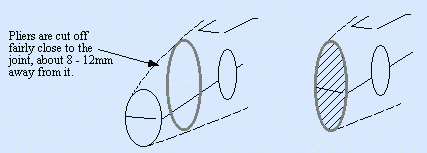How to Make Prong Notching Pliers
These pliers notch round prongs easily to a given depth and replace a bur for the job. They are made to suit a specific size prong and one makes similar pliers for different prong shapes, but all based on this idea. One obtains a pair of chain nose pliers either new or from a flea market and converts them into prong notching pliers.
1 Minute Read
These pliers notch round prongs easily to a given depth and replace a bur for the job. They are made to suit a specific size prong and one makes similar pliers for different prong shapes, but all based on this idea. One obtains a pair of chain nose pliers either new or from a flea market and converts them into prong notching pliers.
One should use box joint (where one arm of the pliers is inserted through a hole in the other) as they are far superior in strength and stability to side joint pliers. Most pliers will be soft enough to saw into and file. The pliers are cut off flush fairly close (8-12 mm) to the joint as greater pressure is developed closer to the joint (the fulcrum) of the pliers.
A groove is burred into one flat jaw of the pliers using an appropriate burr (a standard burr from the dentist is great). The groove is sunk in to the half-way point of the burr. The diameter of the groove is the same as that of the prong. The distance into the jaws is usually less than 3 mm. The end of the groove functions a stop to the prong wire sliding into the jaws when using the pliers.
The other side of the pliers are filed in such a way that a notching ridge runs across the jaw at the correct height to make a notch in the prong when the prong is inserted in the groove. The end of the groove functions as a stop to keep the position of the notch uniform on the prongs. The area of the jaw filed away to leave the notching ridge is filed to a depth of at least one half the prong depth (if not more).
The prong is inserted into the pliers until it stops, the pliers are firmly squeezed together thus notching the prong. These are especially good for stud earrings and similar settings which are hard to hold. The plier jaws are rounded off and tapered towards the groove as on page 38. [Cheap Thrills in the Tool Shop]
You assume all responsibility and risk for the use of the safety resources available on or through this web page. The International Gem Society LLC does not assume any liability for the materials, information and opinions provided on, or available through, this web page. No advice or information provided by this website shall create any warranty. Reliance on such advice, information or the content of this web page is solely at your own risk, including without limitation any safety guidelines, resources or precautions, or any other information related to safety that may be available on or through this web page. The International Gem Society LLC disclaims any liability for injury, death or damages resulting from the use thereof.
Charles Lewton-Brain
Master goldsmith Charles Lewton-Brain trained, studied and worked in Germany, Canada and the United States to learn the skills he uses. Charles Lewton-Brain is one of the original creators of Ganoksin.
The All-In-One Jewelry Making Solution At Your Fingertips
When you join the Ganoksin community, you get the tools you need to take your work to the next level.
Trusted Jewelry Making Information & Techniques
Sign up to receive the latest articles, techniques, and inspirations with our free newsletter.



